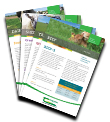
Sheep Newsletter – October 2023
Sheep Newsletter – October 2023 09 October 2023 Type Newsletter Download Publication (PDF) In this month’s edition: Grassland managementOctober is the month to start closing up paddocks if you want to have grass next spring. Remember that you cannot burn a candle at both ends, so if you want to have sufficient grass next spring […]
09 October 2023
Type Newsletter
By

Sheep Newsletter – October 2023
09 October 2023
Type Newsletter
Type Newsletter
Download Publication (PDF)
In this month’s edition:
- Grassland management
October is the month to start closing up paddocks if you want to have grass next spring. Remember that you cannot burn a candle at both ends, so if you want to have sufficient grass next spring to feed ewes after lambing you need to ensure that the fields get a rest period. - Liming
Lime is a great soil conditioner and helps to release fertiliser that is locked in the soil. Anytime is a good time to spread lime, so if you have a lime requirement and ground conditions are suitable you should consider doing so. - Sheep Improvement Scheme
All farmers participating in the Sheep Improvement Scheme (SIS) must purchase an SIS-approved ram in the first three years. Flocks with more than 150 ewes must purchase two rams over the five years. - Mating management
Key points for successful mating are:- rams that are in good body condition have higher levels of libido (desire to mate);
- ideal ewe to ram ratios are 45:1 for mature rams and 25:1 for ram lambs;
- three or more rams per mating group will help to guard against infertility and blocker rams;
- raddle is cheap and the best insurance policy against empty ewes at scanning time – change the colour every two weeks;
- lame sheep are big problem during the mating season – treat lame ewes and rams promptly;
- infections that increase body temperature will render the ram temporarily infertile – be conscious of this for rams that have been purchased close to the breeding season; and,
- avoid dipping rams six weeks prior to the breeding season or during the breeding season due to the risk of post-dipping lameness.
- When is your breeding season?
Most farmers are lambing too early, run out of grass and have to supplement ewes with expensive concentrates post lambing. If this is the situation on your farm then consider delaying ram turnout for two weeks. - Parasites
Over the last few years we have seen an increase in a parasite called Haemonchus contortus (barber’s pole worm), which most farmers are not familiar with. This parasite is different from the general run of mid-season stomach worms in that it can cause rapid death in both lambs and adult sheep. - Research Update – Lamb growth
Philip Creighton, Animal & Grassland Research and Innovation Centre, Teagasc Athenry, Co. Galway details the latest news from the Sheep Research Demonstration Farm, Athenry. Lamb growth rates during July and August were well behind normal here in Athenry, averaging only 130g/head/day. A major issue contributing to this was the high rainfall levels experienced (254% of normal in July and 119% of normal in August), which led to very low grass dry matter (DM) levels of 12-13%. - BETTER Farm Update – Grass growth
Frank Campion, Animal & Grassland Research and Innovation Centre, Athenry, Co. Galway reports on grass growth and the preparations for closing on the BETTER sheep farms. Grass growth rates across the Teagasc BETTER sheep farms have been ahead of where they were this time last year during the past couple of weeks. This will make it easier for flocks to build covers coming into autumn and ensure ewes and lambs both receive good quality grass.
